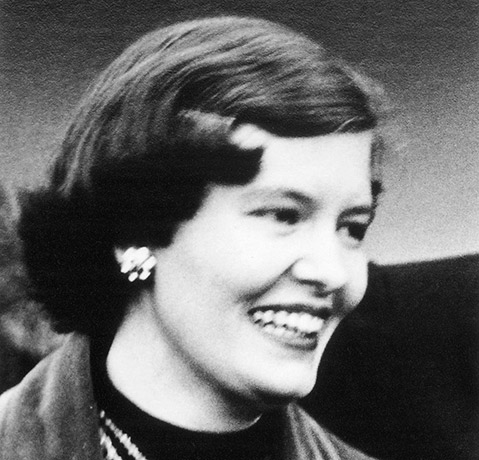
Luckily for our community, good fortune following sad circumstances led Louise Boucher (née Heitfeld) to call Santa Barbara home. Three years after her birth in Wallace, Idaho, Louise’s mother died. When life became insufferable after her father remarried, two uncles conspired to rescue her, first having nuns look after her briefly, then bringing her to Montecito, where one uncle had a second home. When Louise’s father lost custody, her aunt May was appointed guardian and raised her here.
Louise graduated cum laude from Marymount High School and then earned a degree in English from UCSB (“when it was up on the hill,” she’d say). She later met and married photographer Hal Boucher, with whom she would happily spend the rest of her life. Before meeting, both worked at the Biltmore Hotel, without ever crossing paths. She worked in the gift shop. He shared a small office with the publicity director across the corridor. They finally met at a wedding: she a guest, he the photographer. They married in 1952 and had four children (Cathy, Carrie, Tom, and Jon), who later made them proud grandparents of six (Kate, Ciceley, Lauren, William, Carrie, and Jesse).
Hal told me the Biltmore gift shop was “the one job in her life that she got a check for.” The rest of her career was dedicated to the family photography business, raising her children, and volunteer work.
Socially minded Aunt May pushed Louise into joining the Junior League, which began her long and impressive career of public service. Led by her deep and abiding love for our community and her belief in the importance of preserving its beauty and history, Louise served our community in many roles.
She was a boardmember, at times president, of many organizations, including the UCSB Art Affiliates, Eucalyptus Hill Improvement Association, Citizens Coalition, Citizens Planning Association & Foundation, Pearl Chase Society, and Santa Barbara Conservancy. She was a member of the Santa Barbara Trust for Historic Preservation, National Trust for Historic Preservation, S.B. Museum of Art (also a docent there), Los Angeles County Museum of Art, Metropolitan Museum of Art, and Lotusland.
Longtime Santa Barbara Independent writer and columnist Nick Welsh proclaimed, “She sat on every design review committee in city history.” Hyperbole perhaps, but nearly true. She served on the Advisory Landmarks Committee — which became the Landmarks Committee, which later became the Historic Landmarks Commission — Sign Committee (helping to write the Sign Ordinance), Landmark Designations Subcommittee, and El Pueblo Viejo Guidelines Update Subcommittee. She chaired the subcommittee that surveyed the city from the beach to Oak Park and from the freeway to Laguna Street (walking the entire area, cataloging every structure), the subcommittee on awards, and the subcommittee that produced the book El Pueblo Viejo: A Walking Guide.
In 1993, the Historic Landmarks Commission presented her with a resolution in appreciation of her exemplary contributions and personal commitment to the city’s beauty, character, and heritage. In 2003, the Historic Landmarks Commission and Architectural Board of Review presented her with the Saint Barbara Award for her commitment to historic preservation. In 2004, she received the Pearl Chase Historic Preservation and Conservation Award from the S.B. Trust for Historic Preservation.
On her 2005 application to again serve on a city commission, she noted her occupation as “Active Volunteer.” No truer words!
Louise had a real love of architecture, literature, and the arts. She also loved and cared about people. Jaime Limon, senior planner with the City of Santa Barbara, shared with me, “When we would have a private conversation about city business, she ultimately would change the topic toward my children and wanted to know about them. That was the type of caring person she was.” Louise’s longtime friend and colleague Barbara Lowenthal expressed that “Louise will always be in my heart.” That can be said by many.
So many people loved and respected her. So many benefited from her mentoring, particularly those she thought could make a difference, those newly serving on review boards, and me when I was the executive director of Citizens Planning Association & Foundation, working side by side with her for nine years. She was my teacher, mentor, confidante, and dear friend. I relished in her knowledge, dedication, irreverence, and humor. As her friend June Sochel said, reminiscing about Louise, “She had an absolutely wicked wit.”
Welsh has asserted, “However relentless in pursuit of aesthetic orthodoxy, Louise was also known to crack a shrewd joke or three.” One of the things I miss most is her laugh and the glint in her eye when she said something “wicked” or shrewd.
When Louise passed away, an online comment provided an apt summary: “Goodness this woman will be missed. She was active on our behalf right up until the very end. Few people probably knew she was looking over the shoulder of everything that is ‘Santa Barbara.’ Where is the next generation of Santa Barbara watchdogs going to come from who have roots as deep as hers and dedication to the cause to match? You simply cannot replace an institution like Louise with just another person.” Indeed. In both her personal and civic life, Louise is absolutely irreplaceable.
